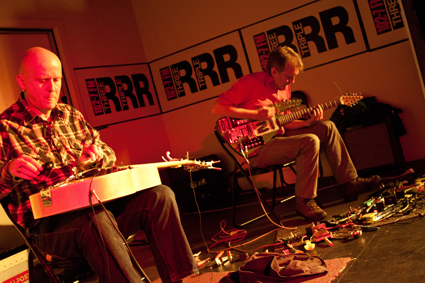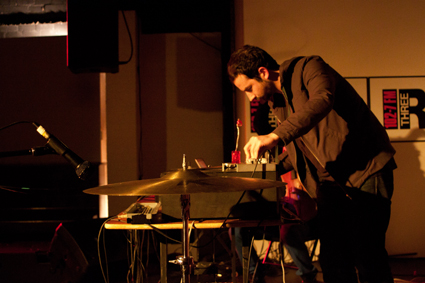reciprocity between sounds
matthew lorenzon: liquid architecture, melbourne

Dave Brown and Lukas Simonis, Liquid Architecture
photo Sebastian Avila
Dave Brown and Lukas Simonis, Liquid Architecture
THE SMALL 3RRR PERFORMANCE SPACE IS AT ONCE A BROADCASTING STUDIO, A CONCERT HALL AND AN INSTALLATION SITE. EACH FUNCTION ENTRAINS A DIFFERENT SET OF CONVENTIONS AFFECTING THE WAY AUDIENCES APPROACH THE MUSIC AND SOUND ART PRESENTED THERE. THROUGH DAVID CHESWORTH’S OCEANOGRAPHY/PERON STATION INSTALLATION AND THE LIQUID ARCHITECTURE CLOSING CONCERT, EACH OF THESE SETS OF CONVENTIONS WERE CHALLENGED BY A PROGRAM THAT ASKED “WHO’S AFRAID OF LAUGHING?,” “WHO’S AFRAID OF THE DARK?” AND, FINALLY, “WHO’S AFRAID OF LISTENING?”
For the Oceanography/Peron Station installation, Chesworth moved away from the large-scale site-specific installations of his and Sonia Lieber’s Wax Sound Media to produce an intimate listening environment in the 3RRR performance space. The dim room invited the audience to apprehend the eight-channel works acousmatically, or on their sonic merit. The striking juxtaposition of synthesised and field-recorded sonic environment provided the listener with a fresh auditory perspective on both sound sets while provoking their curiosity about the works’ extra-musical associations.
Oceanography is an almost completely synthesised soundscape that Chesworth describes as suggesting an “underwater eco-system.” High, diatonic tones shimmer above humming chordal currents, frissons of static, pealing motifs and a sound like a squeaky shopping trolley (an object common to many marine environments). The characteristically dream-like timbral palette and steady but understated pulse, similar to Sigur Ros’ 2004 work Ba Ba Ti Ki Di Do for Merce Cunningham’s dance piece Split Sides, gave the work a theatrical quality well beyond bean-bag- bound listeners’ immediate surroundings.
After the synthesised sounds of Oceanography, the strictly field-recorded bird and insect calls of Peron Station sounded strikingly artificial. The call of the Chiming Wedge-Bill resembles the metallic tinkling of digital artifact in a badly encoded MP3. The White-Winged Fairywren twitters like a tiny super-charged Leslie speaker. Beetle stridulations coalesce in what sounds like a granulated shopping cart. Only the recordings of blowholes and the odd crow betrayed the natural origin of their unearthly sounds.
The installation works developed an engrossing sonic dialogue, although the empty stage and lonely piano pushed against a wall were reminders of the kind of show you were not attending. The performative element of sound art formed the subtext of the Liquid Architecture concert featuring James Rushford and Joe Talia, Lukas Simonis and Dave Brown, Pascal Battus and Marc Behrens.
Paris-based sound artist Pascal Battus explored the sounding properties of styrofoam trays, cassette deck motors, foil, cardboard, plastic cups and other everyday materials in an intimate table-top setting. Battus’ brow knotted in earnest concentration as he strove to find the sweet spot of each object. Sometimes the truly experimental procedure of grinding a piece of acetate against a spinning disc would open up unexpected and remarkable sonic terrain. At other times a muted flatulence would announce the disagreement of two objects coerced into sonic co-operation. The suspense, surprise or disappointment of each experiment was intensely comic, the latter submitted to with a small, decisive nod by the sonic researcher.
Marc Behrens lent a satirical air to his quadraphonic diffusion of characteristic industrial sounds including doors, chains and static. Dressed in a long grey coat with his face aglow from his red laptop screen, Behrens variously stood on, leant against, or lay upon the stool that most laptop performers would slump down on for a performance’s duration. Behrens triggered samples with heroic gestures and concluded the performance with four stiff bows to the audience, who were garishly lit by two red spotlights from under Behrens’ musical pulpit.
While sound artists must be aware of their own performance conventions, I would not want them to sidestep their obligation to provide interesting sounds. As Chesworth’s installation demonstrated, much of the interest of a sound lies not only in its isolated presentation and performative contextualisation, but in its relationship to other sounds. With the exception of certain thin textures consisting of two squealing pieces of styrofoam, Battus’ series of sonic experiments did not provide a sense of the interconnectedness. Despite their brilliant, high fidelity amplification, Behrens’ industrial sounds did not move beyond their own stereotype. Dave Brown and Lukas Simonis’ prepared guitar improvisation set, on the other hand, displayed an almost furious attention to soundscape construction, at least in the short-term interactions of the two guitarists with their armoury of kitchen utensils. Using a pre-recorded tape recording as a compositional tool, Rushford and Talia’s set presented longer-range, episodic changes in texture.

Joe Talia, Liquid Architecture
photo Sebastian Avila
Joe Talia, Liquid Architecture
Though their concert blacks and almost complete lack of lighting initially seemed out of place in a concert exploring the expanded possibilities of concert performance, Rushford and Talia’s subdued presentation resonated with their tense, horror-themed set. A reel-to-reel tape with foley effects and snatches of dialogue from The Evil Dead II provided the underlying structure of the performance. Rushford’s extended viola techniques and Talia’s processed ride cymbal contributed timbral washes and insidious scratching sounds between gasps and creaking doors. Sometimes the texture reduced to a deep rumble, while at other times careening, echoing tones from the viola produced an ear-splitting cacophony. Sometimes, long moments of silence passed in horror-movie suspense, punctuated by a breathy voice asking “are you all right?”
This question seemed to probe the discomfort we can have about unexpected silence in a performance situation, particularly when there is little to look at. What one usually realises, in the awkwardness of the moment, is not the fullness of Cagean silence, but that silence is profoundly changed in relation to the sounds that precede it. This is particularly evident in radio, where the relationship between sound and silence is even more carefully orchestrated than in a concert setting. For instance, as the Rushford/Talia set was broadcast on 3RRR, we were asked to make some crowd noise when the performance space became live. The “on air” sign was greeted with cheers, before which everyone was sitting quietly, conversing in hushed whispers. The sudden intrusion of ‘crowd noise’ in an almost pitch black performance space was absurd, just as a few coughs and creaking seats would have seemed out of place on a ‘live’ radio broadcast.
It is because of the mutual influence of silence and sound, rather than in spite of it, that the presentation of sound art needs to be taken into consideration. The darkness of an acousmatic performance, such as David Chesworth’s installation or Rushford and Talia’s set, encourages the audience’s focus on the reciprocity between sounds, while any visual element is capable of changing the listener’s experience of that relationship, such as Battus’ focused gaze as he tries—and fails—to bring a tin cup and a small motor into consonance.
Liquid Architecture 12, Festival of Sound Arts, Oceanography and Peron Station, composer David Chesworth, 3RRR, June 27-29; concert, Marc Behrens, Pascal Battus, Lukas Simonis, Dave Brown, James Rushford and Joe Talia, 3RRR, Melbourne, June 30
RealTime issue #104 Aug-Sept 2011 pg. 44






